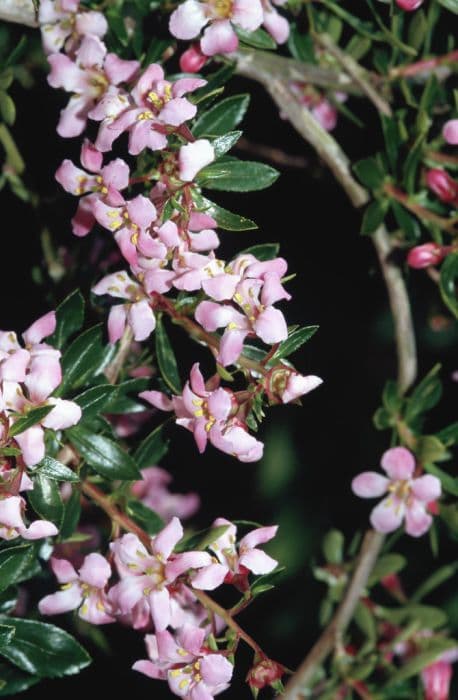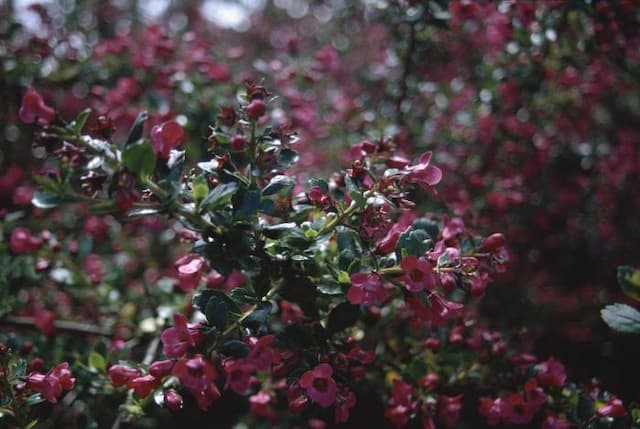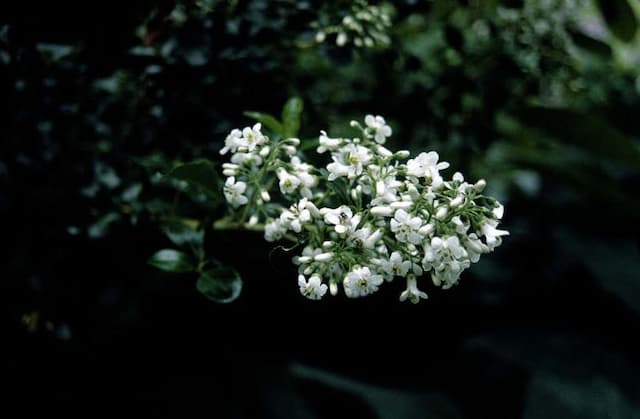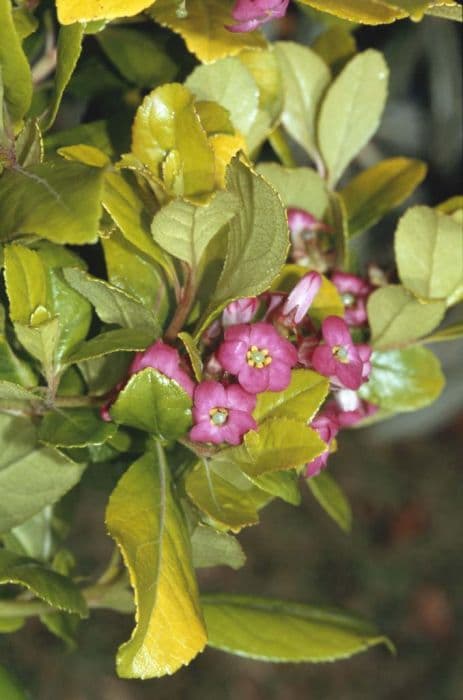Escallonia Escallonia 'Edinensis'

ABOUT
The Escallonia 'Edinensis', commonly referred to simply as Escallonia, is an attractive shrub that is appreciated for its lush appearance. This plant is characterized by its glossy, dark green leaves which have a slightly toothed edge, giving them a somewhat serrated look. The leaves are small to medium in size and are densely packed on the branches, creating a full, bushy appearance that can be quite striking in a garden setting. The Escallonia 'Edinensis' is well-loved for its abundant and showy flowers. These blooms are typically pink in color and have a tubular shape, which is quite appealing to hummingbirds and other pollinators. The flowers are small but numerous, and they grow in clusters that can create a very impressive display when the plant is in full bloom. These flower clusters contrast beautifully with the dark foliage, providing a stunning visual display. Added to its attractive foliage and flowers, the Escallonia 'Edinensis' has a neat, mounded form that can bring structure and order to garden designs. It is a versatile plant that works well in various garden settings, whether it is used as a stand-alone specimen or as part of a hedge or border. The overall appearance of this plant is one of vibrant health and ornamental beauty, making it a favored choice for gardeners looking to add long-lasting color and texture to their landscapes.
About this plant
 Names
NamesSynonyms
Edinburgh Escallonia
Common names
Escallonia 'Edinensis'.
 Toxicity
ToxicityTo humans
Escallonia is generally considered non-toxic to humans. There is no significant evidence to suggest that Escallonia 'Edinensis' or other common varieties of Escallonia pose serious risks if ingested. Therefore, ingestion of this plant typically does not result in poisoning or severe symptoms in humans.
To pets
Escallonia is not commonly known to be toxic to pets either. It is not listed among the plants that are poisonous to cats, dogs, or other domestic animals. Consequently, ingestion of Escallonia 'Edinensis' by pets is not expected to cause significant symptoms or poisoning. However, it is always advisable to keep an eye on your pets and prevent them from eating plants, as individual animals might have different sensitivities or reactions.
 Characteristics
CharacteristicsLife cycle
Perennials
Foliage type
Evergreen
Color of leaves
Green
Flower color
Pink
Height
6-8 feet (1.8-2.4 meters)
Spread
4-6 feet (1.2-1.8 meters)
Plant type
Shrub
Hardiness zones
7
Native area
South America
Benefits
 General Benefits
General Benefits- Ornamental Appeal: Escallonia 'Edinensis', commonly known as Escallonia, adds visual interest to gardens with its glossy green foliage and tubular pink flowers.
- Easy Care: It is known for being low maintenance, requiring minimal care once established.
- Drought Tolerance: Escallonia can withstand periods of dry conditions, making it suitable for water-wise landscaping.
- Pollinator Attraction: The flowers attract bees and butterflies, supporting local pollinator populations which are beneficial for the ecosystem.
- Hedging and Borders: Its dense growth habit makes it ideal for creating hedges or defined borders within garden spaces.
- Wind Resistance: It is capable of withstanding windy conditions, making it suitable for coastal areas and exposed sites.
- Rapid Growth: Escallonia exhibits fast growth, allowing for quick establishment and filling in of garden spaces.
- Evergreen Foliage: Being an evergreen shrub, it provides year-round interest and screen, unlike deciduous plants which lose their leaves in winter.
- Wildlife Shelter: The dense foliage offers shelter for small birds and other wildlife.
- Variety of Landscapes: Its adaptability makes it suitable for a range of landscape styles from formal to cottage gardens.
 Medical Properties
Medical PropertiesThis plant is not used for medical purposes.
 Air-purifying Qualities
Air-purifying QualitiesThis plant is not specifically known for air purifying qualities.
 Other Uses
Other Uses- Escallonia is often used as a natural windbreak in coastal gardens due to its hardy nature and dense foliage.
- This plant can be trained to form a hedge or topiary, providing structure and formality to garden designs.
- Escallonia flowers can be used as a source of nectar for bees, making it an excellent plant for supporting pollinators in the garden.
- The dense growth habit of Escallonia can provide privacy screens for outdoor living spaces or conceal unsightly features like compost bins.
- In some regions, Escallonia branches may be used in traditional basket weaving crafts due to their pliability when young.
- With its attractive berries, Escallonia can provide visual interest in the garden during the autumn and winter months when other plants have died back.
- The glossy, evergreen foliage of Escallonia can be used in flower arrangements as a lasting green backdrop to more colorful blooms.
- Escallonia can be used as an underplanting shrub under the canopies of larger trees, where its tolerance for partial shade will ensure it thrives.
- Gardeners in urban areas may use Escallonia to help reduce noise pollution due to its dense, sound-absorbent foliage.
- Landscapers may utilize the Escallonia plant in a mass planting scheme to stabilize soil and control erosion on slopes.
Interesting Facts
 Feng Shui
Feng ShuiThe Escallonia is not used in Feng Shui practice.
 Zodiac Sign Compitability
Zodiac Sign CompitabilityThe Escallonia is not used in astrology practice.
 Plant Symbolism
Plant Symbolism- Resilience: Escallonia, with its hardy growth habit and evergreen leaves, often symbolizes resilience and endurance, representing the ability to withstand adverse conditions and thrive.
- Protection: With its dense foliage that can be used for privacy hedges, the Escallonia plant can symbolize shelter and protection, offering a safe haven and barrier from outside harm.
- Beauty: The bright, showy flowers of the Escallonia are often associated with beauty and admiration, symbolizing the appreciation of aesthetics and the joy of nature's splendor.
- Healing: In some cultures, plants are revered for their medicinal properties. Escallonia's use in traditional medicine may make it a symbol of healing and wellness.
- Bounty: As a plant that can produce an abundance of flowers, Escallonia may represent bounty and generosity, celebrating nature’s plentiful gifts.
 Water
WaterEscallonia, commonly known as escallonia, prefers consistently moist soil, but it is also important not to overwater as this can lead to root rot. Water this plant thoroughly once a week, providing about 1 to 2 gallons per plant, ensuring the water penetrates deeply into the soil to encourage deep root growth. During hot and dry spells, you may need to water escallonias twice a week, particularly if they are young plants or in containers. Adjust watering during the winter months or rainy periods, as the plants will require less. Always check the soil moisture level a few inches down; if the soil is dry, it's time to water.
 Light
LightEscallonia thrives in a spot with full sun to partial shade, with at least six hours of sunlight a day being optimal for its growth and flowering. This plant grows best when it receives morning sun and some afternoon shade, especially in hotter climates, to protect it from the intense heat of the late day. Situate escallonias where they will receive ample light to ensure the best growth and blooming potential.
 Temperature
TemperatureEscallonia plants are hardy in a range of temperatures and can survive in conditions as cold as 15 degrees Fahrenheit, though they prefer a milder climate. The ideal temperature range for escallonia is between 50 to 75 degrees Fahrenheit, as they enjoy a moderate climate. However, they can tolerate brief periods of higher heat if they are well-watered and have some protection from the hottest part of the day.
 Pruning
PruningPrune escallonia plants to maintain their shape and encourage bushier growth. The best time to prune is in late winter or early spring before new growth begins. Deadheading spent flowers can also promote further blooming. Trim back any dead or damaged branches to keep the plant healthy, and prune lightly each year to shape the plant and control its size.
 Cleaning
CleaningAs needed
 Soil
SoilEscallonia, commonly known as Escallonia, prefers well-draining soil with a slightly acidic to neutral pH of 6.0 to 7.0. A mix of loam, peat, and sharp sand or perlite is ideal for proper drainage and root health. Adding organic matter such as compost enriches the soil and encourages vigorous growth.
 Repotting
RepottingEscallonia should be repotted every 2 to 3 years to refresh the soil and allow for root growth. Younger plants may benefit from more frequent repotting while mature Escallonias are repotted less often.
 Humidity & Misting
Humidity & MistingEscallonia thrives in moderate humidity levels but is quite adaptable and can tolerate different humidity conditions as long as proper watering practices are followed.
 Suitable locations
Suitable locationsIndoor
Ensure bright light, moderate humidity, and good airflow for indoor Escallonia.
Outdoor
Plant in well-draining soil, full sun to partial shade, and shelter from strong winds.
Hardiness zone
7-10 USDA
 Life cycle
Life cycleEscallonia 'Edinensis', also known as Edinburgh Escallonia, begins its life cycle as a seed, which upon germination develops into a young seedling with a primary root system. As it grows, it establishes a more robust root system and develops foliage, progressing through a vegetative stage where it focuses on leaf and stem growth to maximize photosynthesis. After reaching maturity, which can vary depending on environmental conditions, it enters the reproductive stage where flowers develop, typically from early summer to fall, attracting pollinators with its pink or white blooms. Following pollination, the flowers produce seeds, thereby completing the reproductive cycle. In the following seasons, the plant continues to grow and repeat the flowering and seeding process, capable of living for many years if conditions are suitable. Edinburgh Escallonia is also able to propagate vegetatively, through cuttings, which is a common practice for gardeners to generate new plants.
 Propogation
PropogationPropogation time
Spring-Early Summer
The most popular method of propagation for Escallonia 'Iveyi', commonly known as Iveyi Escallonia, is through semi-hardwood cuttings. This process is typically carried out in the late summer. A healthy, disease-free branch is selected, and a cutting of about 6 to 8 inches (15 to 20 centimeters) is made. The lower leaves are stripped, and the cut end is often dipped in rooting hormone to encourage root development. This cutting is then placed in a well-draining rooting medium such as a mix of peat and perlite or sand and kept moist until roots develop, which can take several weeks. Once rooted, the cuttings can be transplanted to individual pots or directly into the garden.

![Escallonia [Golden Carpet]](/_next/image?url=https%3A%2F%2Fplants-admin.emdemapps.com%2Fimages%2Fplants%2F%2Fimages%2F604b59284be41.png&w=640&q=75)


![Escallonia [Pink Elle]](/_next/image?url=https%3A%2F%2Fplants-admin.emdemapps.com%2Fimages%2Fplants%2F%2Fimages%2F604b630962bc2.png&w=640&q=75)




